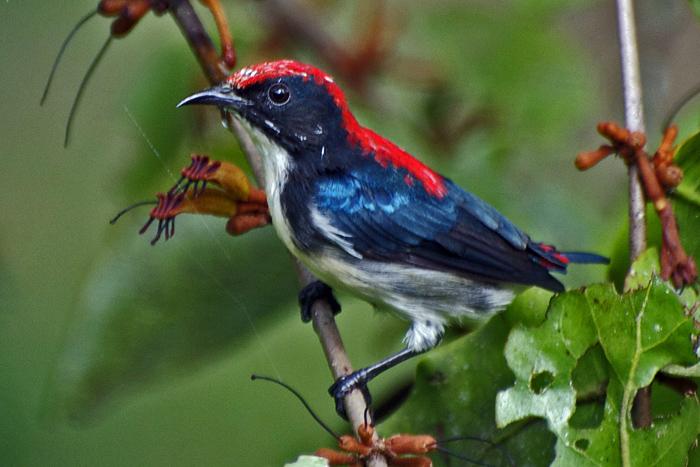
Dicaeum cruentatum
TAXONOMY
Certhia cruentata Linnaeus, 1758, Bengal (India). Seven subspecies.
OTHER COMMON NAMES
English: Pryer’s flowerpecker; French: Dicйe а dos rouge; German:
Scharlachmistelfresser; Spanish: Pica Flor de Lomo Carmнn.
PHYSICAL CHARACTERISTICS
3.5 in (8.9 cm); 0.19–0.28 oz (5.5–8 g). Red stripe from forehead
to base of tail; blue-black wings and tail; and whitish belly.
DISTRIBUTION
D. c. batuense: Mentawai Islands; D. c. cruentatum: northeast India
to southern China, eastern Thailand, Indochina, Sumatra, and
Riau Archipelago; D. c. ignitum: peninsular Malaysia; D. c. niasense:
Nias Island; D. c. nigrimentum: Borneo; D. c. simalurense: Simeulue
Island; D. c. sumatranum: Sumatra and surrounding islands.
HABITAT
Forests, secondary growth, orchards, plantations, and gardens
up to 3,300 ft (1,000 m) mostly, but attains more than 6,900 ft
(2,100 m) in Nepal.
BEHAVIOR
Strong flier, aggressive and restless in treetops but occasionally
feeds low in bushes; hawks for insects. Moves up and down
mountains with the seasons.
FEEDING ECOLOGY AND DIET
Fruits, especially of mistletoes, figs, berries, seeds, nectar, spiders,
and insects.
REPRODUCTIVE BIOLOGY
Two to four gray eggs laid in tiny oval pouch, made by both
sexes, of grass and suspended 6.6–49 ft (2–15 m) up in tree; entrance
near top sometimes has porch.
CONSERVATION STATUS
Not threatened. Common in most of range but rare in Bhutan
and Nepal.
SIGNIFICANCE TO HUMANS
None known.
Photo Gallery of - Scarlet-backed flowerpecker




 Animalia Life
Animalia Life